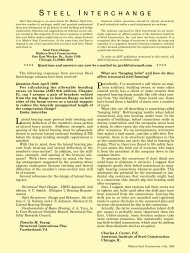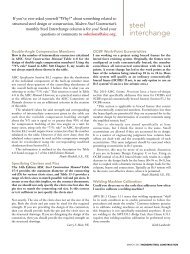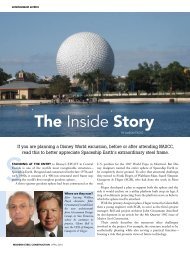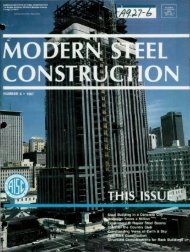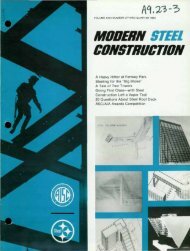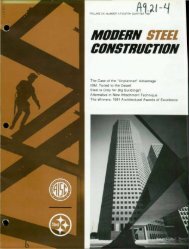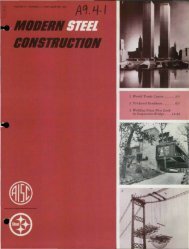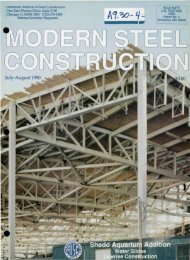The Right Way to Camber a Beam - Modern Steel Construction
The Right Way to Camber a Beam - Modern Steel Construction
The Right Way to Camber a Beam - Modern Steel Construction
You also want an ePaper? Increase the reach of your titles
YUMPU automatically turns print PDFs into web optimized ePapers that Google loves.
HORIzONTaLLy aND vERTICaLLy CURvED<br />
MEMbERS HavE become a popular choice for building<br />
and bridge construction. <strong>The</strong>re are two main reasons: architectural<br />
expression and, perhaps more commonly, because<br />
of how they carry and distribute loads in the structure. <strong>The</strong><br />
action of an arch makes it possible <strong>to</strong> cover significant spans,<br />
since the load is carried largely in compression instead of<br />
through bending action. For certain arch geometries, support<br />
conditions, and load distributions, the effects of the imposed<br />
loads translate in<strong>to</strong> uniform compression within the<br />
entire arch.<br />
In addition <strong>to</strong> complete structures such as arches, individual<br />
curved structural members are also used. Common<br />
<strong>to</strong> most building applications is the fact that the curving<br />
of such members is very often done at ambient (room)<br />
temperature.<br />
Possibly the most common curved member is a beam<br />
that has been cambered <strong>to</strong> satisfy certain deflection limitations,<br />
<strong>to</strong> ensure that the beam is near level when the structure<br />
is placed in service. <strong>Camber</strong>ing criteria vary but are<br />
most often expressed as a certain fraction of the anticipated<br />
dead load deflection. <strong>The</strong> principles are self-explana<strong>to</strong>ry; the<br />
actual implementation of cambering varies a great deal from<br />
structure <strong>to</strong> structure, from designer <strong>to</strong> designer, and from<br />
fabrica<strong>to</strong>r <strong>to</strong> fabrica<strong>to</strong>r.<br />
How <strong>to</strong> bend for <strong>Camber</strong>ing<br />
Straightening, cambering, and curving of structural<br />
shapes are all representative of bending that involves<br />
local yielding of the steel <strong>to</strong> varying degrees. Although<br />
the principles and basic mechanics of these processes are<br />
the same, they are used for significantly different purposes<br />
and with very different magnitudes of the bending<br />
deformations and the strains that develop in the crosssection.<br />
A certain amount of plastic deformation must take place<br />
in the cross-section during the process in order for the curving<br />
operation <strong>to</strong> work. Elastic bending and stress analysis<br />
cannot be used, since any deformations taking place under<br />
such conditions will revert <strong>to</strong> zero once the applied force or<br />
moment is removed.<br />
Straightening<br />
ASTM Standard Specification A6/A6M gives detailed<br />
requirements for bars, plates, shapes, and sheet piling used<br />
in construction (ASTM, 2008). Among these, it provides<br />
the permitted variations for straightness for rolled shapes.<br />
For example, the maximum out-of-straightness, e, for wideflange<br />
shapes with a flange width larger than or equal <strong>to</strong> 6 in.<br />
is determined as<br />
shop and field issues<br />
<strong>The</strong> <strong>Right</strong> <strong>Way</strong> <strong>to</strong> <strong>Camber</strong> a beam<br />
Knowing when <strong>to</strong> drill holes in cambered members is<br />
key <strong>to</strong> reducing the likelihood of cracking.<br />
e = 1 ⁄8 x [(number of feet of <strong>to</strong>tal length)/10]<br />
with the value of e in inches. This translates in<strong>to</strong> approximately<br />
1 ⁄1,000 of the length of the shape. <strong>The</strong> requirement is<br />
the same for camber and sweep, which are the ASTM terms<br />
for out-of-straightness measured relative <strong>to</strong> the strong and<br />
weak axes, respectively.<br />
Out-of-straightness is measured by the steel mill during<br />
the production of the shapes, and straightening is<br />
applied <strong>to</strong> make any non-conforming element meet the<br />
ASTM A6 requirements. Depending on the size of the<br />
shape, the straightening is either done in continuous fashion,<br />
or if the shape is heavy, it is done through point application<br />
of loads. <strong>The</strong> former procedure is referred <strong>to</strong> as<br />
roller or rotary straightening; the latter is known as gag<br />
straightening.<br />
In rotary straightening the local yielding takes place<br />
continuously along the length of the shape. Gag straightening<br />
causes local yielding in the shape only in short segments<br />
along the length of the member, surrounding each<br />
of the load application points. Common <strong>to</strong> both of these<br />
methods is the fact that the amount of curving and the accompanying<br />
strain demands within the cross section are<br />
very small, and the radius of curvature of the bent member<br />
is very large.<br />
Straightening of shapes <strong>to</strong> meet delivery standards is used<br />
by all of the world’s steel mills. <strong>The</strong> methods and results are<br />
the same, and the equipment that is used operates on the<br />
same principles and applications.<br />
In view of the discussion of cambering that follows, however,<br />
it is essential <strong>to</strong> bear in mind that the shapes that are<br />
mill-straightened have no holes or attachments<br />
of any kind. <strong>The</strong> shapes are<br />
straightened as they come off the cooling<br />
bed in the steel mill.<br />
<strong>Camber</strong>ing<br />
For a structural engineer, cambering<br />
a beam means <strong>to</strong> pre-bend the member<br />
in the direction opposite <strong>to</strong> the deflection<br />
that will be developed by the anticipated<br />
gravity loads. <strong>The</strong> aim is <strong>to</strong> have<br />
a structural component that is horizontal<br />
or nearly so following the application of<br />
the most closely known load component.<br />
Since the dead load is generally known<br />
more accurately than the live load, for example,<br />
cambering is almost always done<br />
<strong>to</strong> an extent that equals a fraction or even<br />
all of the dead load deflection.<br />
by reidar bjorhovde<br />
Reidar Bjorhovde is president<br />
of the Bjorhovde Group, Tucson,<br />
Ariz.<br />
november 2008 MODERN STEEL CONSTRUCTION
a close-up of a camber crack through a<br />
W-shape flange with a punched bolt hole.<br />
Structural cambering can be accomplished<br />
through selective heating of areas<br />
of the shape, or, as is most common,<br />
through gag pressing at ambient temperature<br />
of the member while it is installed in<br />
a cambering frame. Cold cambering does<br />
involve yielding of small areas of the cross<br />
section, similar <strong>to</strong> gag straightening. <strong>The</strong><br />
accompanying deformation demands for<br />
the steel in the shape are very small, and<br />
the force necessary <strong>to</strong> develop the camber<br />
curve tends <strong>to</strong> be fairly small.<br />
While the deformation and force demands<br />
associated with cambering are small, it is important<br />
<strong>to</strong> bear in mind the modifications of<br />
the cross-sectional area that will occur as a result<br />
of punching or drilling of bolt holes and<br />
similar fabrication operations. Some fabricating<br />
shops are set up for holes <strong>to</strong> be made at the<br />
beginning of the various operations, running<br />
the shape through the beam line with preprogrammed<br />
hole sizes and locations. <strong>The</strong> cambering<br />
is then done at a later stage.<br />
<strong>The</strong> cross-sectional area changes associ-<br />
a full-flange transverse crack of a W21×93<br />
taking place during cambering.<br />
MODERN STEEL CONSTRUCTION november 2008<br />
ated with punching or drilling can create a<br />
preferred plane for yielding, with the potential<br />
for localized failure during the cold cambering<br />
process. Further, procedures such as<br />
punching have a tendency <strong>to</strong> leave the inside<br />
and the lower edge of the hole fairly rough.<br />
Micro-cracks may develop inside or at the<br />
edge of the holes, with significant potential<br />
for crack propagation and overall failure of<br />
the shape during the cambering operation.<br />
While sub-punching and reaming the holes<br />
and/or grinding the hole edges may help, it<br />
will not prevent cracking in many cases. This<br />
is particularly important for the holes that<br />
are located at or near center span of the beam.<br />
Small cracks may even appear near drilled<br />
holes that were made before cambering.<br />
Cracking during cambering has been observed<br />
on a number of occasions in beams that<br />
met all ASTM and structural design requirements.<br />
As a result of the potential for cracking,<br />
it is strongly recommended that holes<br />
and similar features near the location of the<br />
maximum cambering deformation should be<br />
made after the cambering is completed.<br />
Material Properties<br />
When the steel has been deformed <strong>to</strong><br />
produce local yielding, it has undergone<br />
permanent deformations that are not removed<br />
upon unloading of the material.<br />
Upon reloading, the steel response appears<br />
<strong>to</strong> indicate a material with a yield stress and<br />
elongation properties as defined by the “new”<br />
stress-strain curve. If there is only a small<br />
or even no yield plateau, which is typical of<br />
higher strength materials, the reloading response<br />
appears <strong>to</strong> be for steel with a yield<br />
stress that is larger and an elongation at rupture<br />
that is smaller than the corresponding<br />
properties of the virgin material. If the steel<br />
has been strained in<strong>to</strong> the strain hardening<br />
range, the change in the apparent mechanical<br />
properties can be substantial.<br />
This behavior must be considered when<br />
planning the curving operations for structural<br />
shapes. Specifically, a part of the cross<br />
section must be deformed plastically in order<br />
for the curving <strong>to</strong> work. <strong>The</strong> extreme<br />
fibers in the cross section will be strained<br />
well beyond the level of the initial yield of<br />
the steel. If there are stress concentrations<br />
such as holes in the flange(s) of the beam,<br />
the magnitude of the strain that is imposed<br />
by the cambering operation may reach the<br />
fracture level at the edges of the holes, with<br />
subsequent propagation in the cross section.<br />
Delaying Drilling<br />
It is the fabrica<strong>to</strong>r’s responsibility <strong>to</strong> prevent<br />
cracking during cambering, and they<br />
should make every possible effort <strong>to</strong> do so,<br />
including delaying drilling. In many cases, in<br />
order for a beam <strong>to</strong> be properly cambered, it<br />
is essential <strong>to</strong> delay some of the hole punching,<br />
drilling, and similar operations until<br />
after the bending is done. This will ensure<br />
that cracks will not be initiated at the locations<br />
of the holes. Specifically, it is recommended<br />
that holes at the center of the span<br />
should be drilled after the cambering has<br />
been completed. (Note that the scheduling of<br />
punching/drilling is a fabrica<strong>to</strong>r issue and not<br />
something that engineers need <strong>to</strong> add <strong>to</strong> their<br />
specifications or inspection requirements.)<br />
When the beam has been cambered successfully,<br />
with no buckling or localized cracking<br />
in the steel, the member will experience<br />
strains under actual service conditions that<br />
are much smaller than those that are associated<br />
with the bending operation.<br />
reFerenCeS<br />
american Society for Testing and materials<br />
(aSTm) (2008), Standard Specification for<br />
General Requirements for Rolled Structural<br />
<strong>Steel</strong> Bars, Plates, Shapes, and Sheet Piling,<br />
Standard no. a6/a6m.<br />
bjorhovde, r., engestrom, m.F., Griffis,<br />
L.G., Kloiber, L.a., and malley, j.o. (2001),<br />
Structural <strong>Steel</strong> Selection Considerations – A<br />
Guide for Students, Educa<strong>to</strong>rs, Designers and<br />
Builders, american Society of Civil engineers<br />
(aSCe), res<strong>to</strong>n, virginia, and aiSC.<br />
bjorhovde, r. (2006), “Cold bending of<br />
Wide-Flange Shapes for <strong>Construction</strong>,”<br />
Engineering Journal, aiSC, vol. 43, Fourth<br />
Quarter 2006 (pp. 271-286).<br />
Larson, j.W. and huzzard, r.K. (1990), “economical<br />
Use of <strong>Camber</strong>ed <strong>Steel</strong> beams,”<br />
Proceedings, 1990 National <strong>Steel</strong> <strong>Construction</strong><br />
Conference, aiSC (pp. 13-1 –13-21).<br />
ricker, d.T. (1989), “<strong>Camber</strong>ing <strong>Steel</strong><br />
beams,” Engineering Journal, aiSC, vol. 26,<br />
Fourth Quarter (pp. 136–142).<br />
Schlafly, T. (2006), “Fabrication and erection,”<br />
Chapter 2 of Structural <strong>Steel</strong> Designers<br />
Handbook, 4th edition, roger L. brockenbrough<br />
and Frederick S. merritt, edi<strong>to</strong>rs,<br />
mcGraw-hill book Company, new york.



